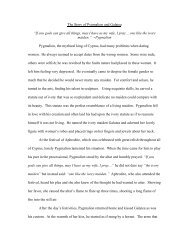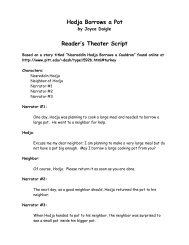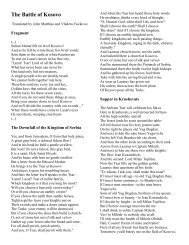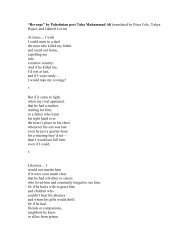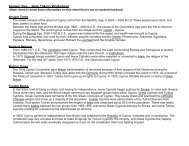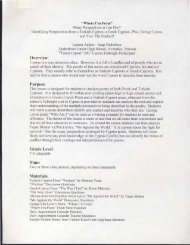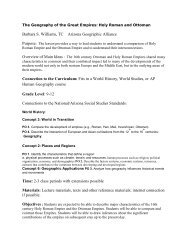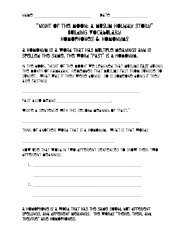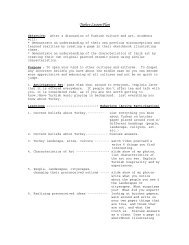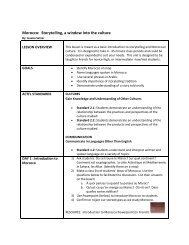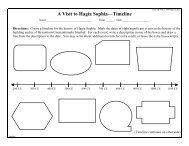An Interdisciplinary Cyprus Lesson Plan
An Interdisciplinary Cyprus Lesson Plan
An Interdisciplinary Cyprus Lesson Plan
You also want an ePaper? Increase the reach of your titles
YUMPU automatically turns print PDFs into web optimized ePapers that Google loves.
<strong>An</strong> <strong>Interdisciplinary</strong> <strong>Cyprus</strong> <strong>Lesson</strong> <strong>Plan</strong><br />
By: Julie Nedved and Jenn Muniz (Language Arts Teacher, collaborator)<br />
Grade Level: 7<br />
Duration: 3 weeks<br />
Arizona Standards:<br />
S1C1PO1: Interpret historical data displayed in graphs, tables, and charts.<br />
S1C1PO4: Formulate questions that can be answered by historical study and<br />
research.<br />
S1C1PO6: Determine the credibility and bias of primary and secondary sources.<br />
S1C1PO7: <strong>An</strong>alyze cause and effect relationships between and among individuals and/or<br />
historical events.<br />
S2C9PO1: Describe current events using information from class discussions and various<br />
resources (e.g., newspapers, magazines, television, Internet, books, maps).<br />
S4C1PO3: Interpret maps, charts, and geographic databases using geographic<br />
information.<br />
S4C1PO4: Locate physical and cultural features (e.g., continents, cities, countries,<br />
significant waterways, mountain ranges, climate zones, major water bodies, landforms)<br />
throughout the world.<br />
S4C1PO5: Interpret thematic maps, graphs, charts, and databases depicting various<br />
aspects of the United States and world regions.<br />
S4CO2PO1: Describe the human and physical characteristics of places and regions.<br />
Overview:<br />
<strong>Cyprus</strong> is a nation with a complex history and several topics of interest to students. In<br />
this unit, students are taught a mural to understand the more complex issues of <strong>Cyprus</strong><br />
and choose 3 topics (geography is required) to research for an expository paper.<br />
Session one: Mural<br />
This mini-lesson builds students’ background knowledge of <strong>Cyprus</strong>.<br />
Materials:<br />
Mural Map<br />
Objectives: Students will be able to explain how the island is divided, two of the major<br />
religions, and how the other nations of the world view the division.<br />
<strong>An</strong>ticipatory Set: Students are shown the “Mural Map” on a transparency and are told to<br />
describe what they see and make predictions about what it means.<br />
Procedure: The teacher will read the following ‘story’ about the mural map and refer to<br />
the mural transparency while reading.
“In the middle of the Mediterranean Sea, there is an island named <strong>Cyprus</strong>. <strong>Cyprus</strong> is a<br />
part of the Middle East. The island is divided in two. The United Nations keeps<br />
peacekeeping troops between the two parts of the island in an area call the ‘green line’<br />
or the ‘buffer zone’. The green line goes through the middle of <strong>Cyprus</strong>’ capital, Nicosia.<br />
People must go through checkpoints to cross through one side to the other. The north<br />
side of the island has its own flag, but most of the world has given it a ‘thumbs-down’.<br />
They do not recognize it as a nation. On the flag is the symbol of Islam, although many<br />
Cypriots in north do not practice the religion. Most of them speak Turkish, and their flag<br />
looks very similar to Turkey’s flag.<br />
The south part of the island has a flag that shows the island of <strong>Cyprus</strong> and two olive<br />
branches, which are symbols of peace. Most of the south is Greek Orthodox (Christian)<br />
and most of the world recognizes them as a nation. Most people speak Greek.”<br />
Review the pictures in the mural with the students again. They may have questions (Why<br />
did the world give the north a ‘thumbs-down’?), but remind students that this is going to<br />
be their research project and that they may choose to research the conflict if they are<br />
interested in learning more. This is an introductory lesson, and students should write<br />
down their questions for research possibilities.<br />
Then, review the mural by asking students questions about the different pictures on the<br />
mural.<br />
Closure: Show the mural on the transparency. Tell students to write the ‘story of <strong>Cyprus</strong>’<br />
on their exit cards.<br />
Session Two:<br />
Objective:<br />
Students will choose their research topics for their <strong>Cyprus</strong> research paper.<br />
Materials:<br />
Research Paper Topic Selection Goals and Objective<br />
<strong>Cyprus</strong> Powerpoint.<br />
Prepare the powerpoint to play on a continuous loop so that students can see images<br />
related to the different topics that they may select. Explain to students that they are to<br />
choose two topics, in addition to Geography, to explore and write about in their research<br />
paper.<br />
While the powerpoint is running, you may read the notes (on the powerpoint slideshow)<br />
to the students so that they may take note of which topics interest them and write down<br />
questions about those topics.<br />
Session Three-Eight<br />
Objective: Students will Boolean search (using google.com) for information regarding<br />
<strong>Cyprus</strong> and narrow their topics
Materials:<br />
Computer Lab<br />
Research Grid<br />
a) Using a computer projected onto a large screen, the teacher will model a search for a<br />
<strong>Cyprus</strong> topic.<br />
For example, search “<strong>Cyprus</strong>” on www.google.com. Explain to students that the millions<br />
of sites you found need to be narrowed down.<br />
Then, try to search using “<strong>Cyprus</strong>” and “geography”. Show students that there are still<br />
far too many sites found. Show students that they can eliminate tourist websites by<br />
searching for “<strong>Cyprus</strong>” and “geography” and “not tourism”.<br />
b) Choose a website demonstrate to students how to record important information from a<br />
website. Include URL, Author, Page Title, Site Title, Organization, and<br />
Date.<br />
c) Students begin to research with teacher’s help. The students must have 3 sources---at<br />
least one web source, one online encyclopedia, and a third source of their own choosing.<br />
(They may choose another web source.)<br />
Students will probably need 4-5 days to complete their research grids.<br />
Session 9-13<br />
Objective: Students will receive scoring guide and plan out their research paper.<br />
Materials: <strong>Cyprus</strong> Research Paper Scoring Guide<br />
Students receive scoring guide. If you would like your students to use a different<br />
organizational guide for their papers, please change this on the scoring guide before<br />
passing it out.<br />
Students will need 4-5 days to complete an organizational plan, write a rough draft, revise<br />
their rough draft, and write a final draft.<br />
Grading:<br />
For Scoring, please refer to the “<strong>Cyprus</strong> Research Paper Rubric”.




